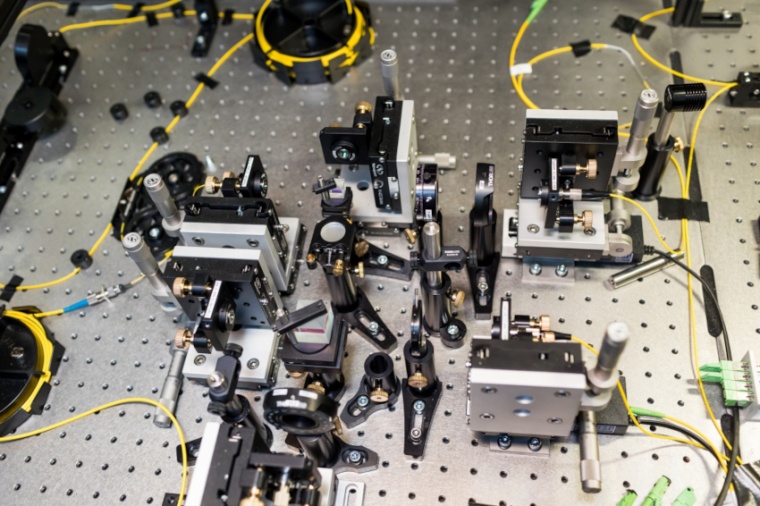A linear path to efficient quantum technologies
Bell-state measurements open up new perspectives for photonic quantum technologies.
Quantum science not only has revolutionized our understanding of nature, but is also inspiring groundbreaking new computing, communication and sensor devices. Exploiting quantum effects in such quantum technologies typically requires a combination of deep insight into the underlying quantum-physical principles, systematic methodological advances, and clever engineering. And it is precisely this combination that researches in the group of Stefanie Barz at the university of Stuttgart and the Center for Integrated Quantum Science and Technology (IQST) have delivered in recent study, in which they have improved the efficiency of an essential building block of many quantum devices beyond a seemingly inherent limit.

The first step in the development of quantum entanglement involved a passionate debate between Albert Einstein and Niels Bohr. In a nutshell, their argument was about how information can be shared across several quantum systems. Importantly, this can happen in ways that have no analogue in classical physics. The discussion that Einstein and Bohr started remained largely philosophical until the 1960s, when the physicist John Stewart Bell devised a way to resolve the disagreement experimentally. Bell’s framework was first explored in experiments with photons.
Bell himself died in 1990, but his name is immortalized not least in the Bell states. These describe the quantum states of two particles that are as strongly entangled as is possible. There are four Bell states in all, and Bell-state measurements – which determine which of the four states a quantum system is in – are an essential tool for putting quantum entanglement to practical use. Perhaps most famously, Bell-state measurements are the central component in quantum teleportation, which in turn makes most quantum communication and quantum computation possible. But when experiments are performed using conventional optical elements, such as mirrors, beam splitters and waveplates, then two of the four Bell states have identical experimental signatures and are therefore indistinguishable from each other. This means that the overall probability of success is inherently limited to 50 percent if only such linear optical components are used.
This is where the work of the Barz group comes in. Doctoral researchers Matthias Bayerbach and Simone D'Aurelio carried out Bell-state measurements in which they achieved a success rate of 57.9 percent. But how did they reach an efficiency that should have been unattainable with the tools available? Their outstanding result was made possible by using two additional photons in tandem with the entangled photon pair. It has been known in theory that such auxiliary photons offer a way to perform Bell-state measurements with an efficiency beyond 50 percent. However, experimental realisation has remained elusive.
One reason for this is that sophisticated detectors are needed that resolve the number of photons impinging on them. Bayerbach and D'Aurelio overcame this challenge by using 48 single-photon detectors operating in near-perfect synchrony to detect the precise states of up to four photons arriving at the detector array. With this capability, the team was able to detect distinct photon-number distributions for each Bell state – albeit with some overlap for the two originally indistinguishable states, which is why the efficiency could not exceed 62.5 percent, even in theory. But the 50-percent barrier has been busted. Furthermore, the probability of success can, in principle, be arbitrarily close to 100 percent, at the cost of having to add a higher number of ancilla photons.
Also the most sophisticated experiment is plagued by imperfections, and this reality has to be taken into account when analysing the data and predicting how the technique would work for larger systems. The Stuttgart researchers therefore teamed up with Peter van Loock, a theorist at the Johannes Gutenberg University in Mainz and one of the architects of the ancilla-assisted Bell-state measurement scheme. Van Loock and Barz are both members of the BMBF-funded PhotonQ collaboration, which brings together academic and industrial partners from across Germany working towards the realisation of a specific type of photonic quantum computer. The improved Bell-state measurement scheme is now one of the first fruits of this collaborative endeavour.
Although the increase in efficiency from 50 to 57.9 percent may seem modest, it provides an enormous advantage in scenarios where a number of sequential measurements need to be made, for example in long-distance quantum communication. For such upscaling, it is essential that the linear-optics platform has a relatively low instrumental complexity compared to other approaches. Methods such as those now established by the Barz grou extend our toolset to make good use of quantum entanglement in practice – opportunities that are being explored extensively within the local quantum community in Stuttgart and in Baden-Württemberg, under the umbrella of initiatives such as the long-standing research partnership IQST and the recently inaugurated network QuantumBW. (Source: U. Stuttgart)











